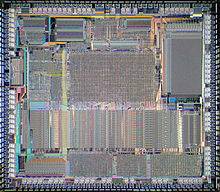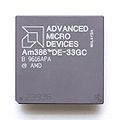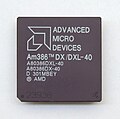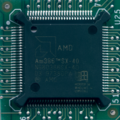Am386
Am286 | |
| Successor | Am486 |
|---|---|
The Am386 CPU is a 100%-compatible clone of the Intel 80386 design released by AMD in March 1991. It sold millions of units, positioning AMD as a legitimate competitor to Intel, rather than being merely a second source for x86 CPUs (then termed 8086-family).[1]
History and design


While the AM386 CPU was essentially ready to be released prior to 1991, Intel kept it tied up in court.
While Intel's 386 CPUs had topped out at 33
-
An Am386DX-25
-
The Am386DE-33 is an embedded version of the Am386DX-33
-
A PGA Am386DX-40
-
A PQFP Am386DX-40 on a 132-pin PGA adapter
-
AMD Am386DE Block Diagram There is not a Paging Unit like a DX CPU
-
A scan of an AMD Am386™DX-40 mounted on a PGA adapter.
Am386DX data
- 32-bit data bus, can select between either a 32-bit bus or a 16-bit bus by use of the BS16 input
- 32-bit physical address space, 4 Gbyte physical memory address space
- fetches code in four-byte units
- released in March 1991
| Model number | Frequency | FSB | Voltage | Power |
Socket |
|---|---|---|---|---|---|
| AMD Am386DX/DXL-20 | 20 MHz | 5 V | 1.05 Watt | 132-pin CPGA
| |
| AMD Am386DX/DXL-25 | 25 MHz | 1.31 Watt | |||
| AMD Am386DX/DXL-33 | 33 MHz | 1.73 Watt | |||
| AMD Am386DX/DXL-40 | 40 MHz | 2.10 Watt | |||
| AMD Am386DX-40 | 3.03 Watt | 132-pin PQFP
| |||
Am386DE data
- 32-bit data bus, can select between either a 32-bit bus or a 16-bit bus by use of the BS16 input
- 32-bit physical address space, 4 Gbyte physical memory address space
- fetches code in four-byte units
- no paging unit
| Model number | Frequency | FSB | Voltage | Power |
Socket | Release date |
|---|---|---|---|---|---|---|
| AMD Am386DE-25KC | 25 MHz | 3-5 V | 0.32-1.05 Watt | 132-pin PQFP |
? | |
| AMD Am386DE-33KC | 33 MHz | 5 V | 1.05-1.35 Watt | |||
| AMD Am386DE-33GC | 132-pin CPGA | |||||
AM386 SX
In 1991 AMD also introduced advanced versions of the 386SX processor – again not as a second source production of the Intel chip, but as a reverse engineered pin compatible version. In fact, it was AMD's first entry in the x86 market other than as a second source for Intel.[7] AMD 386SX processors were available at higher clock speeds at the time they were introduced and still cheaper than the Intel 386SX. Produced in 0.8 μm technology and using a static core, their clock speed could be dropped down to 0 MHz, consuming just some mWatts. Power consumption was up to 35% lower than with Intel's design and even lower than the 386SL's, making the AMD 386SX the ideal chip for both desktop and mobile computers. The SXL versions featured advanced power management functions and used even less power.[7]
-
An Am386SX-25
-
An Am386SX-33
-
An Am386SX-40
Am386SX data
- 16-bit data bus, no bus sizing option
- 24-bit physical address space, 16 Mbyte physical memory address space
- prefetch unit reads two bytes as one unit (like the 80286).
| Model number | Frequency | FSB | Voltage | Power |
Socket | Release date |
|---|---|---|---|---|---|---|
| AMD Am386SX/SXL-20 | 20 MHz | 5 V | 1.68/0.85 Watt | 100-pin PQFP |
1991 | |
| AMD Am386SX/SXL-25 | 25 MHz | 1.84/1.05 Watt | 29 April 1991 | |||
| AMD Am386SX/SXL-33 | 33 MHz | 1.35 Watt | 1992 | |||
| AMD Am386SX-40 | 40 MHz | 1.55 Watt | 1991 | |||
80387 coprocessor
-
An IIT 387SX-25 Coprocessor
-
A Cyrix FasMath 387DX-33 Coprocessor
-
An ULSI 387SX-40 Coprocessor
References
- ^ a b c d "The AMD Am386 DX Processor". cpu-collection.de. 2011. Retrieved 12 November 2011.
- ^ a b c d Shvets, Gennadiy (5 November 2011). "AMD 80386 microprocessor". CPU-World. Retrieved 29 November 2011.
- ISBN 978-0-06-221968-8.
- ^ Pollack, Andrew (2 March 1991). "Intel Loses Trademark Decision". The New York Times.
- ^ "386DX-40 and competitors". the red hill cpu guide. 2011. Retrieved 12 November 2011.
- ^ Linderholm, Owen; Miller, Dan (1 December 1992). "486SX-25s vs. 386DX-40s: the upstart fights back. (evaluations of 30 microcomputers based on Intel Corp.'s 80486SX-25, 80386DX-40 microprocessors) (Hardware Review) (Systems: 486SX-25 vs. 386-40) (Evaluation)". Archived from the original on 1 January 2014. Retrieved 12 November 2011.
- ^ a b c "The AMD Am386 SX Processor". cpu-collection.de. 2011. Retrieved 30 November 2011.
- ^ [1] Archived 2016-03-04 at the Wayback Machine, AMD Datasheet no 15022.
External links
- AMD.com: Am386 Family 32-bit Processors
- AMD Am386SX/SXL/SXLV Datasheet
- cpu-collection.de: Pictures
- AMD: 30 Years of Pursuing the Leader. Part 2
- Shvets, Gennadiy (5 November 2011). "AMD 80386 microprocessor". CPU-World. Retrieved 29 November 2011.
- AMD Am386 Microprocessors for Personal Computers Datasheet 15021 and 15022
- AMD (Advanced Micro Devices) AM386DE-33KC 32-BIT, 33 MHz, MICROPROCESSOR, PQFP132 pdf datasheet












